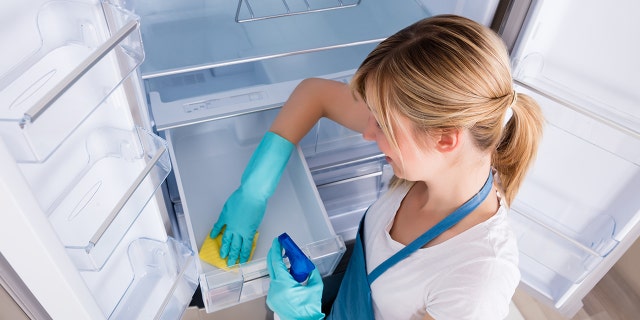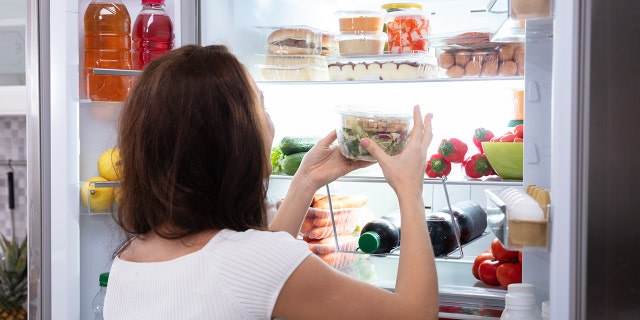Nearly 94,000 pounds of ground beef are being recalled for safety reasons, according to the U.S. Department of Agriculture (USDA).
The department’s Food Safety and Inspection Service (FSIS) warned that meat supplier Tyson Fresh Meat’s facility in Amarillo, Texas, issued a recall on Nov. 16 for 93,697 pounds of raw ground beef products.
The contaminated items were shipped to retailers throughout Texas, the FSIS reported on its dedicated webpage. The group said Tyson Foods notified the FSIS that it had received complaints from people who found “mirror-like” material in ground beef products they purchased.
TYSON FOODS IN TEXAS RECALL 94K POUNDS OF HILL COUNTRY FARE, HEB GROUND BEEF
The recalled products include 10-lb. and 5-lb. chubs (tubed ground beef) labeled “HILL COUNTRY FARE GROUND BEEF 73% LEAN/ 27% FAT” with the “best before or freeze by” date of Nov. 25, 2022, and 5-lb. chubs labeled “H-E-B GROUND CHUCK GROUND BEEF 80% LEAN/ 20% FAT.”
The items also have the establishment number “EST. 245E” printed on the seam, the FSIS noted.
Nearly 94,000 pounds of ground beef products shipped to Texas retailers are being recalled for safety reasons, according to the USDA.
(iStock)
In a press release dated Nov. 15 and shared with Fox News Digital, Tyson Foods said, “Tyson Fresh Meats is voluntarily recalling 93,679 pounds of ground beef product that could be contaminated with hard mirror-like pieces.”
The company continued, “The affected product was produced at an Amarillo, Texas, facility on November 2nd, 2022, and distributed to one retail customer in Texas. No other ground beef products are affected by this voluntary recall and there have been no reports of injury or illnesses.”
It’s not enough to just throw out contaminated food from the fridge due to a food recall.
The statement also noted, “Consumers with questions may call Tyson Consumer Relations department at 1-855-382-3101 Monday through Friday, 8 a.m. to 5 p.m. CST.”
Taking care with food products, contamination
With the Thanksgiving holiday nearly here, friends and family are preparing to cook and bring food and recipe ingredients into homes — so it’s important to stay safe.
SHOULD YOU DRINK WATER BEFORE BED? EXPERTS CHIME IN
The Centers for Disease Control and Prevention (CDC) is reminding Americans it’s not enough to throw out contaminated food from the fridge due to a food recall.
“When food is recalled because of germs like E. coli or Listeria, check your fridge,” the CDC shared recently on Twitter.

“Throw out the recalled food if you have it — and clean your refrigerator right away,” the CDC said.
(iStock)
“Throw out the recalled food if you have it — and clean your refrigerator right away.”
The germs from contaminated food can spread to shelves and drawers in the fridge, the CDC added.
“There are two different families of bacteria: pathogenic bacteria, the kind that cause foodborne illness, and spoilage bacteria, the kind of bacteria that cause foods to deteriorate and develop unpleasant odors, tastes and textures,” the U.S. Department of Agriculture (USDA) notes on its website.
AMERICA’S ‘UNIQUE’ THANKSGIVING STUFFING PREFERENCES STATE-BY-STATE
People should also be cautious about cross-contamination, such as with deli meat and surfaces in the fridge.
It’s easier to be aware of spoilage bacteria, which grows at cold temperatures and causes food to smell or taste bad, the USDA added.
“Even when contaminated deli meat is wrapped and in the refrigerator, people may not realize that they might have touched the lunch meat and then touched the refrigerator door handle or opened a drawer in the refrigerator after making a sandwich,” Jennifer J. Quinlan, Ph.D., a professor in the department of nutrition sciences at Drexel University in Philadelphia, Pennsylvania, told Fox News Digital.
Know the ‘danger zone’
“Bacteria grow rapidly between the temperatures of 40° F and 140° F,” the USDA warns on its website.

Bacteria as seen through a microscope. Bacteria grow rapidly between the temperatures of 40° F and 140° F, the USDA warns on its website.
(iStock )
This is known as the “danger zone.”
People may not be aware pathogenic bacteria are present because they don’t typically alter the smell, taste or the food’s appearance.
SPERM COUNTS AND CONCENTRATIONS DECLINING GLOBALLY SINCE 1970S BUT FERTILITY IMPLICATIONS UNKNOWN: STUDY
It’s easier to be aware of spoilage bacteria, which grows at cold temperatures and causes food to smell or taste bad, the USDA added.
“Most people would not choose to eat spoiled food, but if they did, they probably would not get sick,” the USDA also said.
“Listeria was also more likely to be present the higher the temperature in the refrigerator was above the recommended 40-45 degrees F.”
Some bacteria, such as Listeria monocytogenes, grow well at cold temperatures, so they might grow in the fridge, potentially causing illness.
“Since Listeria likes the cold, it could then survive in the refrigerator and you could actually touch it and contaminate another food not usually associated with Listeria,” added Quinlan, who has conducted research on bacterial contamination and foodborne pathogens found in home kitchens.
“So it’s really about [the] potential for cross contamination,” she added.
Some 45% of the homes tested positive in her study found a foodborne pathogen, with Listeria present in 15% of the homes on refrigerator doors, shelves and meat drawers.

Some bacteria, such as Listeria monocytogenes, grow well at cold temperatures, so they might grow in the fridge, potentially causing illness.
(iStock)
“Listeria was also more likely to be present the higher the temperature in the refrigerator was above the recommended 40-45 degrees F,” said Quinlan.
She added, “So making sure your refrigerator is running cold enough is also very important to staying safe.”
“Don’t leave food out of the refrigerator for more than two hours,” the CDC advised.
Here are five simple steps to keep your fridge germ-free when there’s a food recall.
1. Discard the recalled food
First remember to have the following items ready: sealable bags; hot, soapy water and clean towels.
CHRISTINA APPLEGATE’S MS: HERE’S WHY EARLY SYMPTOMS ARE OFTEN OVERLOOKED
Step one is to throw out the recalled food. Remember to also discard all food that’s stored with it or that has touched it.
Place the contaminated food in a sealed bag in the garbage, but if it was in a container that was reusable, wash the container with warm, soapy water before reusing it.
2. Empty the fridge
Step two is to remove all the items in the fridge and place them aside on a flat surface.

(Ground beef shown on left, and refrigerator cleaning process shown on right. Remember to wipe down shelves and drawers with a towel after cleaning.)
“Don’t leave [food] out of the refrigerator for more than [two] hours,” the CDC advised.
3. Wash all items as well as the fridge’s removable parts
Step three is to wash all removable parts of the fridge by hand with hot, soapy water, but “don’t run cold glass shelves or drawers under hot water because the glass could crack,” the CDC noted.
The agency reminds people to use hot, soapy water to wipe any surface that held any items or parts of the fridge in the cleaning process.
“Let them come to room temperature first.”
SECRETS OF GETTING INTO THE HOLIDAY SPIRIT THIS YEAR: GIVE BACK TO OTHERS
Then use a clean towel to dry the shelves and drawers.
4. Clean the inside of the fridge
Step four is to clean inside the fridge with hot, soapy water, then rinse with clean water, the CDC said.
CLICK HERE TO SIGN UP FOR OUR LIFESTYLE NEWSLETTER
“Don’t forget to wipe inside the doors and any drawers that cannot be removed.”
After using hot, soapy water, the CDC noted an optional step to sanitize the fridge with a solution of one tablespoon of liquid bleach in one gallon of water to further clean it.

Remember, too, to wash your hands with soap and water after the cleaning is all completed.
(iStock)
Use a clean towel to dry the inside of the fridge.
5. Replace items carefully
The final step is to place all shelves, drawers and removed items back into the fridge.
The agency reminds people to use hot, soapy water to wipe any surface that held any items or parts of the fridge in the cleaning process.
CLICK HERE TO GET THE FOX NEWS APP
Also, “wash any towels you used to dry the refrigerator before using them again,” the CDC advised.
Remember, too, to wash your hands with soap and water after the cleaning is completed.
Deirdre Reilly of Fox News Digital contributed reporting to this article.